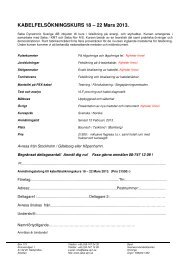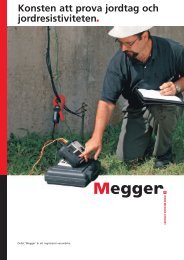A practical guide to earth resistance testing - Weschler Instruments
A practical guide to earth resistance testing - Weschler Instruments
A practical guide to earth resistance testing - Weschler Instruments
You also want an ePaper? Increase the reach of your titles
YUMPU automatically turns print PDFs into web optimized ePapers that Google loves.
other points, causing changes in <strong>earth</strong> resistivity. Graded soil around<br />
construction sites or buried objects such as pipes can cause such localized<br />
deviations. Therefore, you want <strong>to</strong> get some degree of flatness or leveling<br />
off of your curve <strong>to</strong> make such a variation easily noticeable. At the same<br />
time, remember that the <strong>resistance</strong> will rise again in the electrical field of<br />
the current probe, so measurements in this area are <strong>to</strong> be avoided.<br />
As a <strong>practical</strong> example of this effect, consider the case illustrated in Fig.<br />
14. This shows two <strong>earth</strong> <strong>resistance</strong> curves for two locations of C. Curve A<br />
was obtained when C was 100 ft from the <strong>earth</strong> electrode; Curve B when<br />
C was 700 ft away. Curve A shows that C was <strong>to</strong>o close <strong>to</strong> the <strong>earth</strong><br />
electrode; Curve B shows the desired tendency <strong>to</strong>ward leveling out of<br />
the measured <strong>resistance</strong>. The 62 percent distance gives <strong>resistance</strong> values<br />
nearly the same in this case since the <strong>earth</strong> resistivity is fairly uniform.<br />
Simplified Fall-of-Potential Test: The preferred test method is <strong>to</strong> always<br />
gather sufficient data <strong>to</strong> plot the actual curve of <strong>resistance</strong> vs. distance.<br />
In the event that this is impossible, a simplified test might be used with<br />
a compromise on accuracy. This procedure is similar <strong>to</strong> that outlined<br />
under Fall-of-Potential Method as described in IEEE Standard No. 81 (see<br />
references), but you start with P midway between the <strong>earth</strong> electrode<br />
and C.<br />
This reading with P at 50 percent of the distance from the <strong>earth</strong> electrode<br />
<strong>to</strong> C is noted as R 1 . Reference probe P is then moved <strong>to</strong> a location 40<br />
percent of the distance <strong>to</strong> C. The reading at this point is noted as R 2 . A<br />
third reading, R 3 , is made with P at a 60 percent distance. The average of<br />
R 1 , R 2 and R 3 is calculated as R A . You determine the maximum deviation<br />
from the average by finding the greatest difference between individual<br />
readings and the average. If 1.2 times this percentage is less than your<br />
desired test accuracy, R A can be used as the test result. As an example of<br />
this technique, use the data from curve B in Fig. 14 as follows:<br />
R 1 = 58 Ω R 2 = 55 Ω R 3 = 59 Ω<br />
R A = 55 + 58 + 59 = 57.3 Ω<br />
3<br />
R A - R 2 = 57.3 - 55 = 4.0%<br />
R A 57.3<br />
4.0% x 1.2 = 4.8%<br />
If your desired accuracy was 5 percent, 57 Ω (R A ) could be used as the<br />
result. If the result is not within the required accuracy, probe C has <strong>to</strong><br />
be placed farther away and the tests repeated. This method can give<br />
sufficient accuracy but will always give values on the low side. (See<br />
discussion following with reference <strong>to</strong> Table II.)<br />
Fig. 14: Example of how C location affects the <strong>earth</strong> <strong>resistance</strong> curve<br />
Some Rules of Thumb on Spacing P and C: For <strong>testing</strong> a single <strong>earth</strong><br />
electrode, C can usually be placed 50 ft from the electrode under test,<br />
with P placed about 31 ft away. With a small grid of two <strong>earth</strong> electrodes,<br />
C can usually be placed about 100 <strong>to</strong> 125 ft from the electrode under<br />
test; P correspondingly can be placed about 62 <strong>to</strong> 78 ft away. If the <strong>earth</strong><br />
electrode system is large, consisting of several rods or plates in parallel, for<br />
32 1-866-254-0962 www.megger.com Getting Down <strong>to</strong> Earth 33




